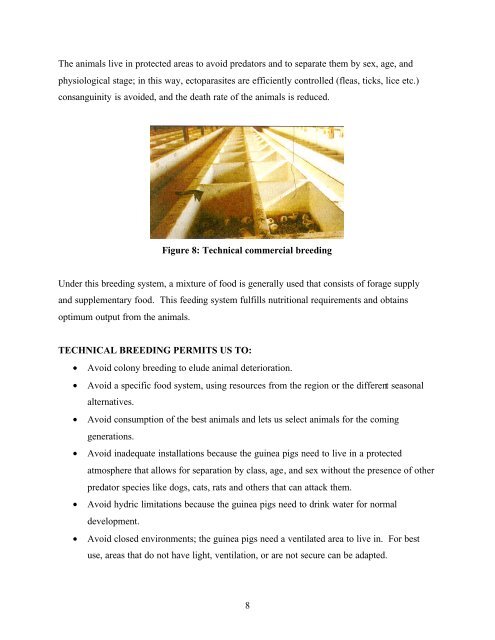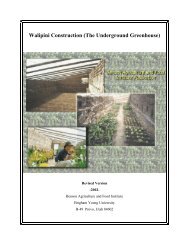GUINEA PIG MANAGEMENT MANUAL - Benson Institute
GUINEA PIG MANAGEMENT MANUAL - Benson Institute
GUINEA PIG MANAGEMENT MANUAL - Benson Institute
Create successful ePaper yourself
Turn your PDF publications into a flip-book with our unique Google optimized e-Paper software.
The animals live in protected areas to avoid predators and to separate them by sex, age, and<br />
physiological stage; in this way, ectoparasites are efficiently controlled (fleas, ticks, lice etc.)<br />
consanguinity is avoided, and the death rate of the animals is reduced.<br />
Figure 8: Technical commercial breeding<br />
Under this breeding system, a mixture of food is generally used that consists of forage supply<br />
and supplementary food. This feeding system fulfills nutritional requirements and obtains<br />
optimum output from the animals.<br />
TECHNICAL BREEDING PERMITS US TO:<br />
• Avoid colony breeding to elude animal deterioration.<br />
• Avoid a specific food system, using resources from the region or the different seasonal<br />
alternatives.<br />
• Avoid consumption of the best animals and lets us select animals for the coming<br />
generations.<br />
• Avoid inadequate installations because the guinea pigs need to live in a protected<br />
atmosphere that allows for separation by class, age, and sex without the presence of other<br />
predator species like dogs, cats, rats and others that can attack them.<br />
• Avoid hydric limitations because the guinea pigs need to drink water for normal<br />
development.<br />
• Avoid closed environments; the guinea pigs need a ventilated area to live in. For best<br />
use, areas that do not have light, ventilation, or are not secure can be adapted.<br />
8



